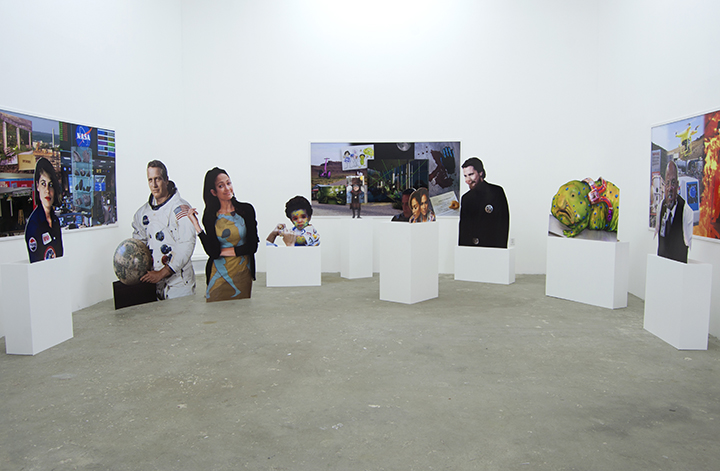If you’d walked into Interstate Projects last week, you might have thought the gallery went dumpster diving in Loews AMC’s deep storage and installed their findings. For his solo show, Nick DeMarco filled the gallery with promo posters, digital collages of space movie landscapes, and life-sized cutouts of famous actors, advertising his imagined feature-length film, Here on Earth. (Basically, it’s visually DIS Magazine’s digital stock image sensibility, which makes sense because DIS did the promo for the show). DeMarco wrote a full script, which sat on a pedestal near the entrance, while the dialogue played from a speaker in the corner. The show’s closed, but the full recording is still online.
The fake poster looks like an ad for the movie Contact, the 1997 Hollywood adaptation of Carl Sagan’s space exploration novel; the poster credits A-listers like J Lo, Paul Newman, baby Drake, Christian Bale, Juliette Lewis, and Billy Joel. Mostly, these are names which call back to economic boom times, a more optimistic era of space heroes and rom coms. In the audio of DeMarco’s imagined movie (he never actually shot the film), C-grade actors voice the parts of, presumably, the lead characters played by Jennifer Lopez and Paul Newman. DeMarco casts them, respectively, as a middle school poetry teacher married to an astronaut, both of whom quickly find their jobs made obsolete by post-recession realities: nationwide arts funding cuts in schools, and Pepsi-sponsored drone space shuttles replacing the “lumbering giant” of NASA’s astronaut program.
Now in need of money to take care of their son (a part-alien mind reader, whom we’re supposed to visualize as baby Drake), our astronaut hero finds his space training mainly applicable to rappelling into his neighbor’s state-of-the-art laser security system, in order to help her fake an art heist and split the insurance money. It’s a funny conceit, even if two hours is a really long time to get ironic optimism spelled out in scripted dialogue. In that way, Here on Earth feels a little more like a thesis than an artwork. But point taken: just as we were beginning to broach new frontiers of space travel and self-expression, those dreams were squashed by robots and bureaucratic overlords.
Eventually, we land in NASA’s new base in Roswell, where their psychic son has to overload a government mind controlling supercomputer. The boy retaliates against the government’s thought policing by releasing all of the information ever created by humans into the public domain: everything from the plans to build a solar power plant, to the plans to build a nuclear weapon. The recording ends with the typical action movie cliffhanger: “Now- what are you gonna do with it?” ~Cue Rage Against the Machine’s “Bulls on Parade”~
Obviously, we’re talking about the Internet. If there’s a moral to Here on Earth, it’s that the government and the corporations may have won control of the economy, but there’s still an intellectual battleground online. Strange times; the heroes are dead, but now we’re all empowered to be one collective hero through social networking. The final line seems to ask whether we’ll use those powers to beat back the machine. When posed as a rhetorical question at the end of the same action movie we’ve been watching for twenty years, though, our prospects do not sound promising.




Comments on this entry are closed.